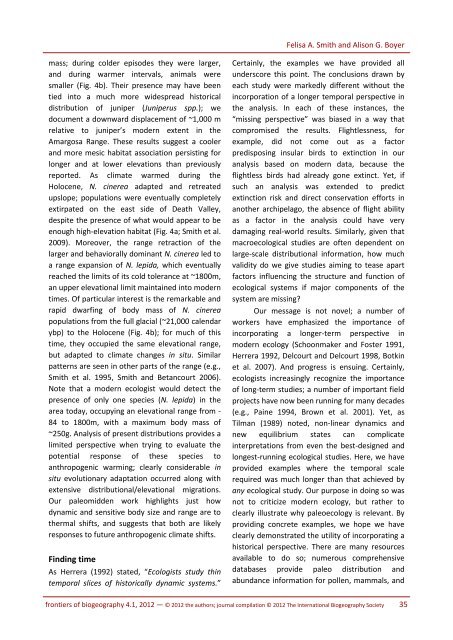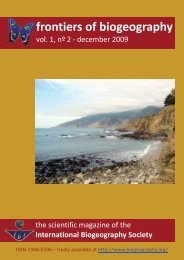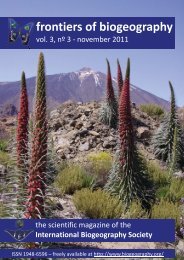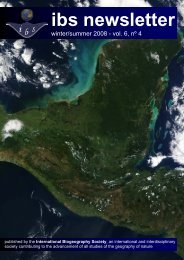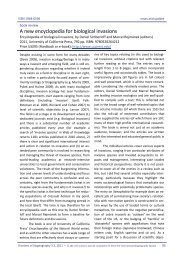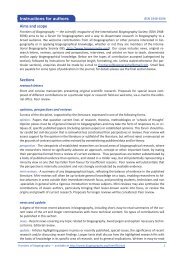1 - The International Biogeography Society
1 - The International Biogeography Society
1 - The International Biogeography Society
- No tags were found...
You also want an ePaper? Increase the reach of your titles
YUMPU automatically turns print PDFs into web optimized ePapers that Google loves.
Felisa A. Smith and Alison G. Boyermass; during colder episodes they were larger,and during warmer intervals, animals weresmaller (Fig. 4b). <strong>The</strong>ir presence may have beentied into a much more widespread historicaldistribution of juniper (Juniperus spp.); wedocument a downward displacement of ~1,000 mrelative to juniper’s modern extent in theAmargosa Range. <strong>The</strong>se results suggest a coolerand more mesic habitat association persisting forlonger and at lower elevations than previouslyreported. As climate warmed during theHolocene, N. cinerea adapted and retreatedupslope; populations were eventually completelyextirpated on the east side of Death Valley,despite the presence of what would appear to beenough high-elevation habitat (Fig. 4a; Smith et al.2009). Moreover, the range retraction of thelarger and behaviorally dominant N. cinerea led toa range expansion of N. lepida, which eventuallyreached the limits of its cold tolerance at ~1800m,an upper elevational limit maintained into moderntimes. Of particular interest is the remarkable andrapid dwarfing of body mass of N. cinereapopulations from the full glacial (~21,000 calendarybp) to the Holocene (Fig. 4b); for much of thistime, they occupied the same elevational range,but adapted to climate changes in situ. Similarpatterns are seen in other parts of the range (e.g.,Smith et al. 1995, Smith and Betancourt 2006).Note that a modern ecologist would detect thepresence of only one species (N. lepida) in thearea today, occupying an elevational range from -84 to 1800m, with a maximum body mass of~250g. Analysis of present distributions provides alimited perspective when trying to evaluate thepotential response of these species toanthropogenic warming; clearly considerable insitu evolutionary adaptation occurred along withextensive distributional/elevational migrations.Our paleomidden work highlights just howdynamic and sensitive body size and range are tothermal shifts, and suggests that both are likelyresponses to future anthropogenic climate shifts.Finding timeAs Herrera (1992) stated, “Ecologists study thintemporal slices of historically dynamic systems.”Certainly, the examples we have provided allunderscore this point. <strong>The</strong> conclusions drawn byeach study were markedly different without theincorporation of a longer temporal perspective inthe analysis. In each of these instances, the“missing perspective” was biased in a way thatcompromised the results. Flightlessness, forexample, did not come out as a factorpredisposing insular birds to extinction in ouranalysis based on modern data, because theflightless birds had already gone extinct. Yet, ifsuch an analysis was extended to predictextinction risk and direct conservation efforts inanother archipelago, the absence of flight abilityas a factor in the analysis could have verydamaging real-world results. Similarly, given thatmacroecological studies are often dependent onlarge-scale distributional information, how muchvalidity do we give studies aiming to tease apartfactors influencing the structure and function ofecological systems if major components of thesystem are missing?Our message is not novel; a number ofworkers have emphasized the importance ofincorporating a longer-term perspective inmodern ecology (Schoonmaker and Foster 1991,Herrera 1992, Delcourt and Delcourt 1998, Botkinet al. 2007). And progress is ensuing. Certainly,ecologists increasingly recognize the importanceof long-term studies; a number of important fieldprojects have now been running for many decades(e.g., Paine 1994, Brown et al. 2001). Yet, asTilman (1989) noted, non-linear dynamics andnew equilibrium states can complicateinterpretations from even the best-designed andlongest-running ecological studies. Here, we haveprovided examples where the temporal scalerequired was much longer than that achieved byany ecological study. Our purpose in doing so wasnot to criticize modern ecology, but rather toclearly illustrate why paleoecology is relevant. Byproviding concrete examples, we hope we haveclearly demonstrated the utility of incorporating ahistorical perspective. <strong>The</strong>re are many resourcesavailable to do so; numerous comprehensivedatabases provide paleo distribution andabundance information for pollen, mammals, andfrontiers of biogeography 4.1, 2012 — © 2012 the authors; journal compilation © 2012 <strong>The</strong> <strong>International</strong> <strong>Biogeography</strong> <strong>Society</strong>35


